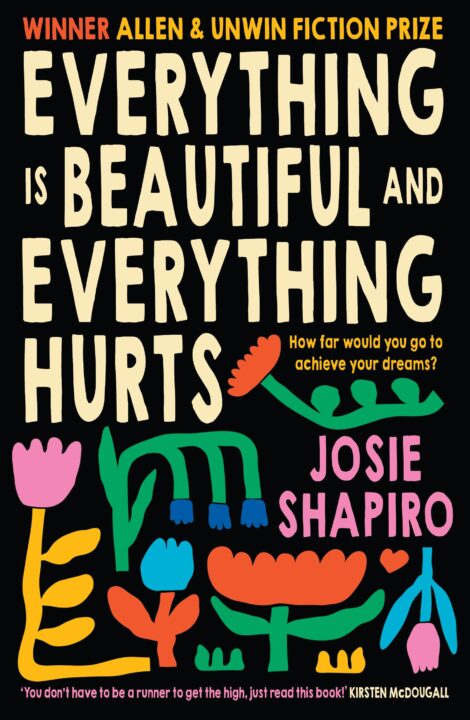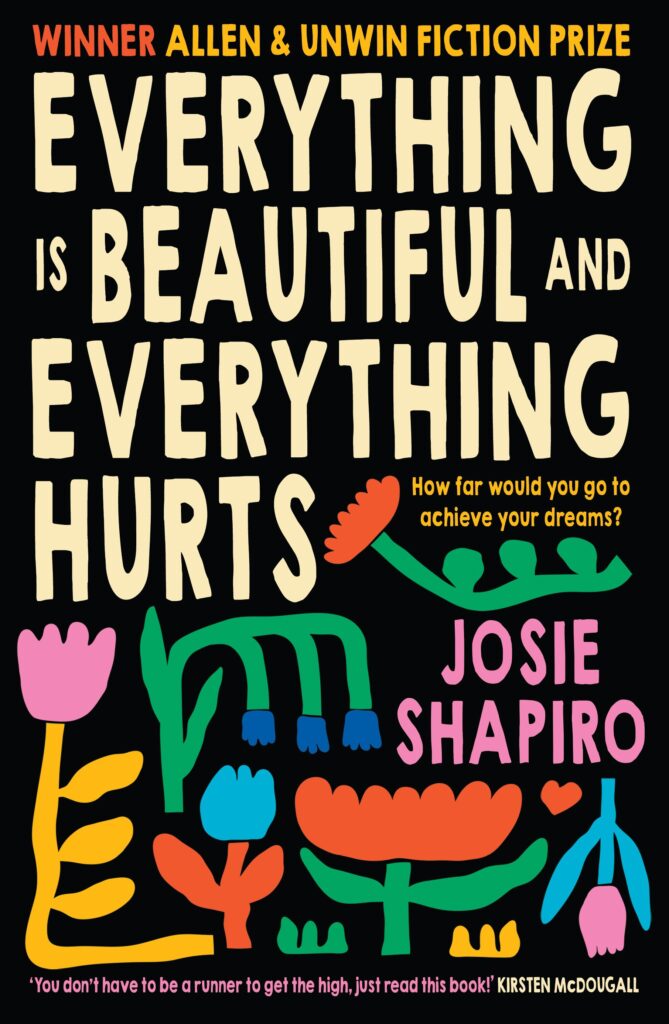Everything is Beautiful and Everything Hurts

Everything is beautiful and everything hurts by Josie Shapiro. Allen & Unwin (2023). RRP: $36.99. 287 pp. ISBN: 978-1-991006-44-8. Reviewed by Rebecca Styles.
The closest I get to running is tripping over my partner’s sneakers. I’ve also waited while his depleted body crossed the finish line of an ultra-marathon. It seems such a punishing way to treat the body. But Shapiro’s debut novel, which won the inaugural Allen & Unwin Commercial Fiction prize last year, shows the delights of running, along with the demands.
Mickey Bloom is the odd one out in her family. Her siblings are older, and more focused on the pursuits of the mind than the body. Her parents are separated, and from the very occasional visits her father makes to the family home, it’s clear the pair don’t see eye to eye. But what she lacks in her relationship with her dad, is made up for in the loving relationship she has with her mum.
The novel starts with Mickey running the Auckland marathon in the present and is punctuated with episodes of her growing up in Ngāmotu in Taranaki. School is a trial for Mickey because of undiagnosed dyslexia causing her to misbehave at school and leading to a lifetime of hating reading. But the cross country at school gives her a chance to excel. Through the back and forth, and then and now, we see Mickey first dream about running in the Olympics, and then fall out of love with running. Finally, we see what brings her back to it.
This book illustrates the intense policing of the female athletic body. Mickey is short—five foot tall—and this is seen as a disadvantage in running. Yet she joins the local athletics group despite her parents’ reservations, and then, when she finishes school, she joins an elite athletic club in Auckland. Part of the routine before training runs is getting weighed in and here callipers are used to measure body fat. There are also talks on diet where Mickey, and no doubt, many like her, get the message that the less you weigh the better you run.
Mickey does find success in running, but it comes with pain. Pain in the body and the mind, pain brought about from the pressure to perform. And being on the receiving end of uninvited sexual advances and casual sexism from the very people who are meant to help her brings her to the brink of exhaustion.
Shapiro’s descriptions of the environment as Mickey runs are beautiful. She hears “the slapping of the tide against the rock wall” (p.10), she notices the first daffodils opening (p.26) and the “autumnal mirk sat over the town” (p.101). Though an adjective that wore a bit thin was the frequently referred to ‘running as flying.’ As a metaphor for Mickey’s revival, it could’ve been used half as often for twice the effect. But on the whole, I felt like I was alongside her on the streets as she ran. Shapiro always brought something fresh to each description of running, which given the sheer number of them, is a great achievement.
While the novel tells the story of one woman’s journey in sport, it also speaks to the larger question of gender equality in sport. In recent years there have been various investigations into the gender bias women experience from sporting organisations, along with a general disregard for their health needs, with high performance being put far ahead of wellbeing.
Shapiro’s solution in the novel is to have a woman train Mickey, and one who fully understands her needs. So, rather than putting women off high performance sport, the answer may be to add more women to the mix at all levels of engagement. An encouraging and hopeful note to end on.
Rebecca Styles (PhD in creative writing at Massey University) has written a novel based on an ancestor’s experience of mental illness at Seacliff Asylum. She’s had short stories published in New Zealand journals and anthologies, and teaches short story writing at Wellington High School Community Education Centre.
